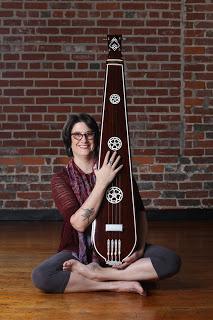
Reclining Nude with Arms Folded Under Her Head by Modigliani
Q: I love the Healthy Aging blog. I read it regularly and don't believe you've covered the topic of radiation as a partial treatment for breast cancer. I'm one year out of treatment but my range of motion is limited; it does not interfere with my everyday life but as a yogi I notice a big difference from side to side. The docs haven't given me much info and I believe the skin has been contracting even after the radiation stopped. I've seen a great PT and work on long, slow, passive stretches, but there's still lots of work to do. Any insights? A: Since I am not familiar with this topic, I asked Cheryl Fenner Brown, one of our guest contributors who has worked with many people following treatment for breast cancer, to help us answer this question. —BaxterBaxter: How does the radiation therapy affect range of motion of the shoulders and arms? Cheryl: Radiation treatments for cancer often cause a host of side effects that may include itchiness, burning, discoloration, dryness, flaking, and tenderness to the skin overlying the breast area. These issues may crop up days, weeks, or even months after the treatments have ended. And in the case of “radiation recall,” which is an inflammatory reaction of the skin near radiation sites after chemotherapy drugs are administered, side-effects may not even start until a year or more after treatment.In breast cancer patients who have received radiation, the delicate skin of the chest and underarm may even feel tight or become thicker due to fibrosis, a thickening and scarring of the connective tissue, or radiation-induced scleroderma, a hardening of the dermal layers. Range of motion may be inhibited due to these complications as well as from muscular tightness resulting from surgery or lymph node removal. Range of motion imbalances for the chest, shoulder ,and arm on the affected side can occur, which may become very apparent during yoga practice. Baxter: Does any other part of the breast cancer treatment or recovery from treatment also affect range of motion and, if so, how? Cheryl: According to the energetic theory of the Integrative Yoga Therapy (based on the wisdom of Ayurveda) in which I was trained, most cancer treatments add “heat” to the body, in the form of chemotherapy, radiation, or other medications, and it is often this additional heat that causes the side effects of nausea, inflammation, joint pain, and dermal damage.Baxter: Can you talk about when you would start offering yoga, and what kinds of practices you would offer? Cheryl: Based on my training in the Integrative Yoga Therapy program, I recommended that patients in treatment, or in the first six-months after treatment, practice any heating forms of yoga or heating subtle practices. So long as the practices are what we call “langhana” practices (which means “reduction” in Sanskrit), and are cooling and relaxing, they are safe for people in treatment to practice. Physical langhana practices may include floor warm-ups, gentle seated or kneeling movements of the spine, shoulders, and hips, standing poses in the Viniyoga system, such as Dynamic Virabhadrasana II, Virabhadrasana I (with hands at the heart), and Trikonasana, chair assisted Surya Namaskar, supported inversions such as Viparita Karani, as well as yin and restorative practices. Use the time during treatment cycle and for six months afterwards to custom fit the yoga practice for your specific needs and to give yourself the time and space to slow down and heal. Contemplative langhana practices are key during this time including cooling and grounding mudras, cooling pranayamas, such as belly breathing, exhale retention, and left-nostril focus pranayama, as well as all forms of guided relaxation or yoga nidra. These practices may help to ease anxiety, calm an overactive mind, and reduce stress. They can also provide a sense of empowerment and mastery over the body to reduce feelings of hopelessness and fear about recurrence. The sense of sangha, or community, that we feel while in class is also a boon for those who are undergoing cancer treatment and can be even more helpful once treatment has ended. Baxter: In addition to what you have already mentioned, what other yoga practices would be helpful?Cheryl: In order to improve range of motion in the chest and shoulders, practitioners could start with my simple Neck & Shoulder Somatic Sequence, working up toward Baxter’s Dynamic Shoulder Sequence using a strap, which will provide feedback on the differences between the two sides of your body. At the six-month post-treatment mark, practitioners can begin to incorporate more “brahmana” (or “expansion”) practices, including deeper backbends and twists, such as Urdhva Dhanurasana and Maricyasana III, more challenging and longer holds of standing postures, such as Virabhadrasana III or Parivritta Trikonasana, energizing mudras, warming pranayamas, and more vigorous styles of practice, such as vinyasa. Always monitor the effects of any practices and proceed carefully into a stronger practice so long as the body remains pain-free and the breath unhindered. Baxter: Are there any other obvious benefits of yoga for those in treatment for breast cancer or following treatment beyond those already mentioned? Cheryl: What we do know about yoga and cancer is that movement, stretching, and pranayama all facilitate lymphatic drainage, which is essential for the health of the immune system. Practicing yoga also can trigger the relaxation response, which encourages a positive immune response. And research on yoga and cancer treatment shows other benefits as well, including improved mood, decrease in feelings of distress and anxiety, less fatigue, and improved sleep and quality of life (QOL) measurements. Baxter: Thanks, Cheryl! This is very helpful and I appreciate all the specific suggestions for people to try.

Follow Baxter Bell, MD on YouTube, Facebook, and Instagram. For upcoming workshops and retreats see Baxter's Workshops and for info on Baxter see baxterbell.com.

